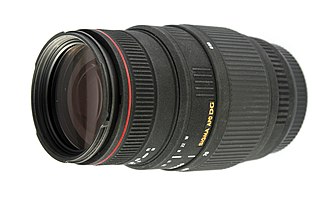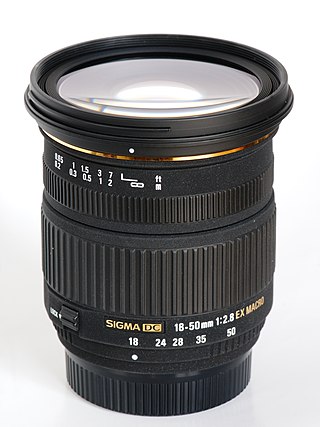
The Four Thirds System is a standard created by Olympus and Eastman Kodak for digital single-lens reflex camera (DSLR) design and development. Four Thirds refers to both the size of the image sensor (4/3") as well as the aspect ratio (4:3). The Olympus E-1 was the first Four Thirds DSLR, announced and released in 2003. In 2008, Olympus and Panasonic began publicizing the Micro Four Thirds system, a mirrorless camera system which used the same sensor size; by eliminating the reflex mirror, the Micro Four Thirds cameras were significantly smaller than the Four Thirds cameras. The first Micro Four Thirds cameras were released in 2009 and the final Four Thirds cameras were released in 2010; by that time, approximately 15 Four Thirds camera models had been released by Olympus and Panasonic in total. The Four Thirds system was quietly discontinued in 2017, six years after the final cameras were released.

Nikkor is the brand of lenses produced by Nikon Corporation, including camera lenses for the Nikon F-mount.
Fujinon is a brand of optical lenses made by Fuji Photo Film Co., Ltd, now known as Fujifilm. Fujifilm's Fujinon lenses have been used by professional photographers and broadcast stations as well as cinematography. Fujifilm started manufacture of optical glass in its Odawara Factory in Japan in 1940, which was the start of the Fujinon brand. They were proud of their use of expensive Platinum crucibles to get the purest glass achievable at the time. Fujifilm also pioneered Electron Beam Coating (EBC) which according to Fujifilm, represented a new high in lens precision and performance. The EBC process was significantly different from other coating processes by the number of coating, the thinness of the coating, and the materials used for coating. Fujifilm claimed they were able to have as many as 14 layers of coating and used materials such as zirconium oxide, and cerium fluoride, which could not be used for coating in the conventional coating process. The first lens to offer the Electron Beam Coating was the EBC Fujinon 55mm F3.5 Macro in 1972. Light transmission for the coating was said to be 99.8%. EBC later evolved into Super-EBC and HT-EBC.

Sigma Corporation is a Japanese company, manufacturing cameras, lenses, flashes and other photographic accessories. All Sigma products are produced in the company's own Aizu factory in Bandai, Fukushima, Japan. Although Sigma produces several camera models, the company is best known for producing high-quality lenses and other accessories that are compatible with the cameras produced by other companies.

The Pentax K-mount, sometimes referred to as the "PK-mount", is a bayonet lens mount standard for mounting interchangeable photographic lenses to 35 mm single-lens reflex (SLR) cameras. It was created by Pentax in 1975, and has since been used by all Pentax 35 mm and digital SLRs and also the MILC Pentax K-01. A number of other manufacturers have also produced many K-mount lenses and K-mount cameras.

The Sigma 30mm f/1.4 EX DC HSM is a wide-aperture photographic lens made by the Sigma Corporation, equipped with a Hyper Sonic Motor. The lens was produced in Canon EF mount, Four Thirds System, Nikon F-mount, Pentax K mount, the SA mount, and the Sony/Minolta AF Mount varieties, all of the same optical formula. It shipped with a removable petal-type lens hood. The lens assumes a crop factor of roughly 1.5, and therefore is not usable with on full-frame or 135 film cameras.

The Sigma 70-300mm F4-5.6 APO DG Macro lens is a consumer-level, telephoto zoom lens made by Sigma Corporation. Different versions of this lens are produced that work with cameras from Canon, Nikon, Pentax, Konica Minolta, Sony and Sigma. Additionally, Olympus' 70–300 f/4–5.6 lens for Four-Thirds has the same optical design and specifications as this lens. The lens is packaged with a lens hood.

The Sigma 50mm f/1.4 EX DG HSM is a normal prime lens made by the Sigma Corporation.

The Sigma 150mm f/2.8 APO Macro EX DG HSM is a telephoto macro prime lenses made by Sigma Corporation.

The Sigma 18-50mm f/2.8 EX DC Macro is a wide to normal angle, zoom lens made by the Sigma Corporation.

The Sigma 200-500mm f/2.8 EX DG lens is a professional-level telephoto zoom lens made by Sigma Corporation. It is notable for being the first lens with an aperture of f/2.8 and a focal length of 500mm. This combination allows very distant objects to be photographed at high shutter speeds in dimmer light, compared to other telephoto lenses. It also allows for very narrow depth-of-field and diffuse bokeh. The main markets for such long, fast lenses are wildlife and sports photographers.

The Sigma 10mm f/2.8 EX DC fisheye is a photographic lens manufactured by Sigma Corporation. It is a diagonal fisheye lens. Unlike most fisheye lenses, this lens is designed for digital SLR cameras that do not have a full 36x24mm sensor. This results in a much greater fisheye effect than is possible when a full-frame fisheye lens is used with a smaller sensor. The projection type of this lens is equidistant

The Sigma APO 180mm F3.5 EX DG lens was a telephoto/macro lens produced by Sigma Corporation. It contained two SLD glass elements to provide correction for chromatic aberration and was aimed toward advanced consumers.

The Sigma 50-500mm f/4-6.3 EX DG HSM is a super-telephoto zoom lens produced by Sigma Corporation. It is commonly known as the "Bigma" because of its long and heavy body. It contains four SLD glass elements to provide correction for chromatic aberration. It is aimed at advanced consumers.

The Sigma 70-200mm f2.8 EX DG OS HSM is a camera lens produced by the Sigma Corporation.

The Leica L-Mount is a bayonet mount developed by Leica Camera AG for interchangeable-lens autofocus digital cameras.

The Canon RF lens mount is an interchangeable-lens mount developed by Canon for its full-frame mirrorless interchangeable-lens cameras, and featured first by the EOS R, followed by the EOS RP. The RF mount was announced in September 2018. In May 2022, Canon announced APS-C EOS R cameras and RF-S lenses designed for these cameras.
















